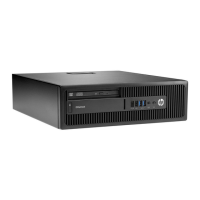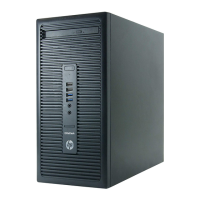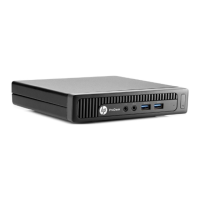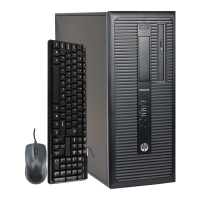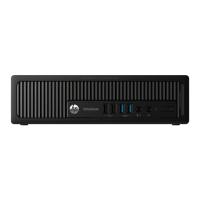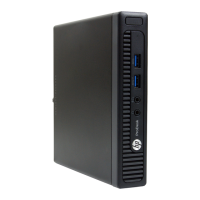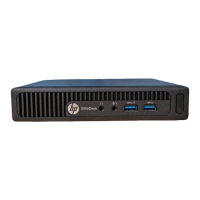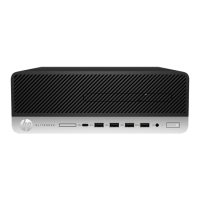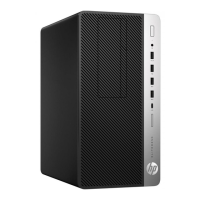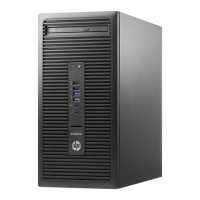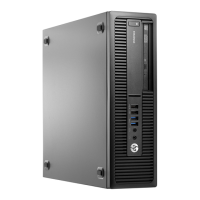Do you have a question about the HP EliteDesk 700 G1 and is the answer not in the manual?
Details the various connectors and indicators on the front of the computer, including USB, audio, and media card reader.
Identifies and describes the connectors and ports on the back of the computer, such as USB, video, and network ports.
Explains where to find the computer's unique serial and product ID numbers for customer service.
Guides users through activating and customizing the operating system in Windows 7.
Covers activation and customization steps for the operating system in Windows 8.
Lists and illustrates the main spare parts for the SFF chassis, including major components.
Details various cables used in the computer system and their specifications.
Lists and illustrates various smaller components and accessories for the computer.
Lists different types of system boards and expansion cards available for the computer.
Lists available hard drives and optical drives, including specifications like capacity and speed.
Explains the risks of ESD and how to prevent damage to computer components.
Provides essential guidelines for operating the computer to prevent overheating and ensure longevity.
Covers general maintenance tasks, including cleaning precautions and procedures for components.
Lists the necessary tools and software required for servicing the computer.
Provides handling precautions and specifications for hard drives.
Outlines essential steps to take before disassembling the computer safely.
Details the procedure for removing and reinstalling the computer's access panel.
Explains how to remove and reinstall the front bezel of the computer.
Covers memory module types and installation procedures for the computer.
Provides instructions for installing, removing, or replacing expansion cards.
Illustrates and identifies system board connectors for various components.
Covers the installation and removal procedures for hard drives and optical drives.
Details the procedure for removing and replacing the computer's power supply unit.
Explains how to remove and reinstall the fan duct for proper airflow.
Describes how to remove and replace the hood sensor component.
Provides steps for removing and reinstalling the front panel input/output assembly.
Outlines the procedure for removing and replacing the computer's system board.
Lists the functions and capabilities of the F10 Computer Setup utility.
Explains the options available in the 'File' section of Computer Setup.
Details storage-related settings and configuration options within Computer Setup.
Covers security features and password management within Computer Setup.
Describes power management settings and options available in Computer Setup.
Explains advanced configuration options for system setup.
Guides users on how to save and restore system configuration settings.
Emphasizes safe and comfortable work environment practices for users.
Provides initial troubleshooting steps to isolate problems before contacting support.
Offers general suggestions and tips for resolving common computer issues.
Addresses common issues like system lockups, incorrect date/time, and cursor problems.
Provides solutions for power-related issues such as intermittent shutdowns and no power.
Offers solutions for issues related to hard drive errors, transaction problems, and detection.
Addresses common problems encountered with media card readers.
Provides solutions for issues related to keyboard and mouse functionality.
Provides solutions for display issues like blank screens, blurry video, and incorrect resolution.
Helps resolve problems encountered when installing new hardware components.
Offers solutions for network connectivity issues, including wake-on-LAN and driver problems.
Provides troubleshooting steps for sound issues, including no sound or low volume.
Guides users on how to resolve common printer issues like not printing or garbled output.
Addresses issues related to memory installation, errors, and insufficient memory.
Provides solutions for processor-related issues like overheating and improper installation.
Offers troubleshooting steps for CD-ROM and DVD drive issues.
Guides users on resolving problems with USB flash drives.
Addresses issues with devices connected to the front panel, like USB and audio ports.
Helps resolve problems related to connecting to the internet and web browsing.
Provides solutions for software-related issues, including application installation and configuration.
Lists POST error codes and messages, with recommended actions for resolution.
Explains how to interpret front panel LED codes and audible beeps for diagnostics.
Explains the benefits and purpose of using HP PC Hardware Diagnostics.
Guides users on how to access and initiate hardware diagnostic tests.
Provides instructions for downloading diagnostic tools onto a USB drive.
Covers methods for backing up, restoring, and recovering data in Windows 8.
Details the process of creating recovery media and system restore points.
Explains various Windows 8 tools for system recovery and restoration.
Covers methods for backing up, restoring, and recovering data in Windows 7.
Explains the system recovery process, including data deletion and OS reinstallation.
Guides users on how to establish and set up passwords for system access.
Details the procedure for clearing or disabling existing setup and power-on passwords.
Explains how to remove setup or power-on passwords from the system.
Describes how to reset CMOS values to factory defaults, affecting system configuration.
Provides instructions and safety precautions for replacing the computer's internal battery.
Details the types of memory and their volatility characteristics in the system.
Lists general requirements for power cord sets applicable worldwide.
Outlines specific power cord requirements for various countries.
Provides technical specifications for the computer's chassis, weight, power supply, and environmental ranges.
| Chipset | Intel Q87 |
|---|---|
| RAM | Up to 32 GB DDR3 |
| Networking | Gigabit Ethernet, optional Wi-Fi |
| Processor | Intel Core i7, i5, or i3 processors |
| Storage | Up to 1 TB HDD or 512 GB SSD |
| Graphics | Intel HD Graphics 4600 or optional discrete graphics |
| Operating System | Windows 7/8/10 Pro |
| Form Factor | Mini Tower, Small Form Factor |
| Ports | USB 3.0, USB 2.0, DisplayPort, VGA, Serial, Audio |
| Audio | High Definition Audio |
| Expansion Slots | PCIe x16, PCIe x1, PCI |
| Power Supply | 240W or 320W |
